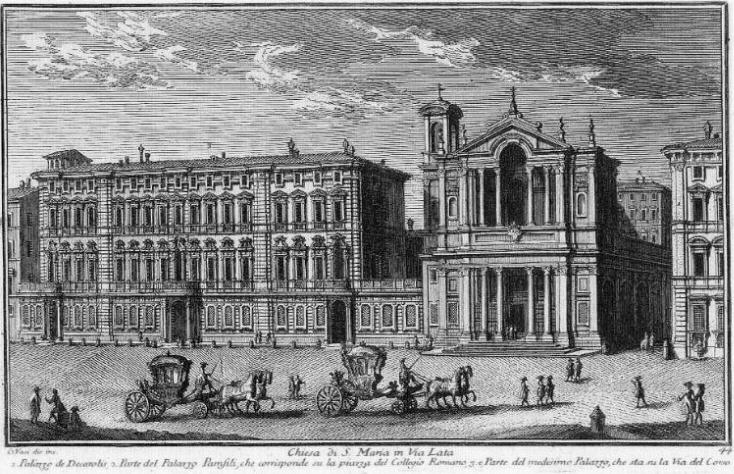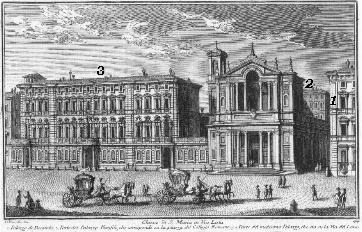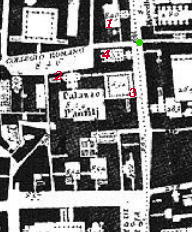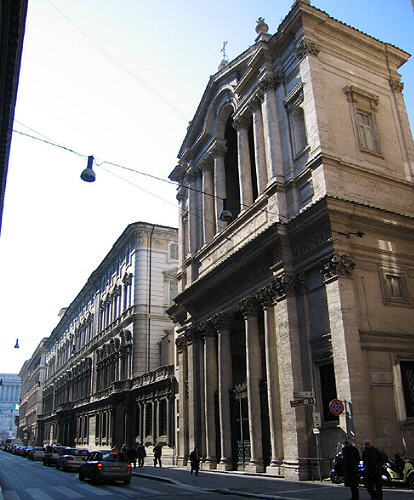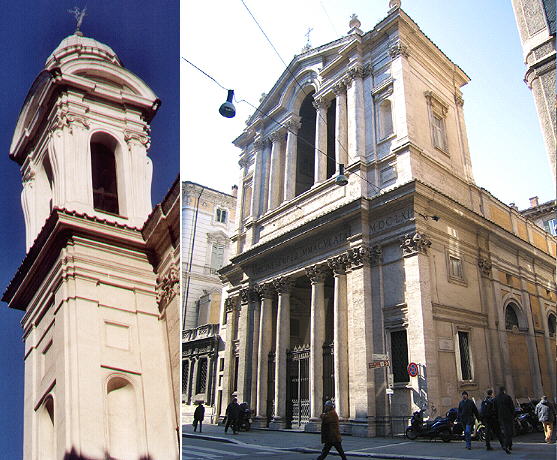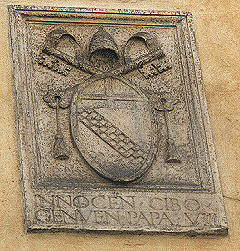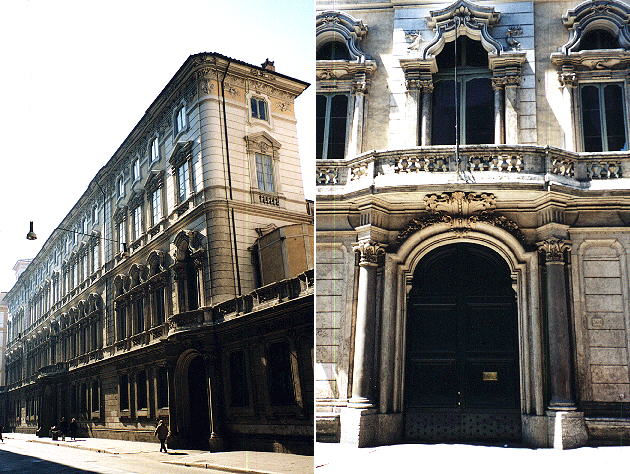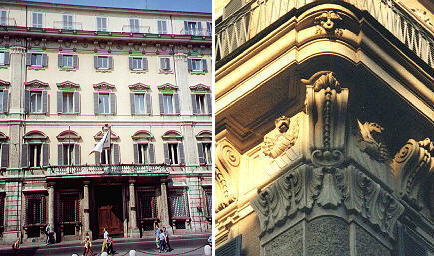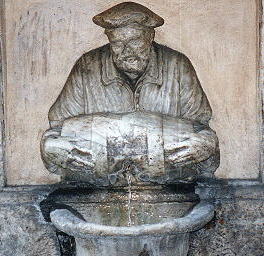

S. Maria
in Via Lata (Book
3) (Map
B2) (Day 1) (View C7) (Rione Pigna)
In this page:
The plate by Giuseppe Vasi
Today's view
S. Maria in Via Lata
Palazzo Doria Pamphili
Palazzo Decarolis
The Plate (No. 44)
Via del Corso was previously called Via Flaminia and Via Lata (wide)
as many other main streets in Italian cities (Via Larga in Florence and
Milan). It goes from north to south so from the shadows we understand it
is noon. The view is taken from the green dot in the map below.
In the description below the plate Vasi made reference to: 1) Palazzo Decarolis; 2) Palazzo Pamfili su Piazza del Collegio Romano; 3) Palazzo Pamfili su Via del Corso.
2) is covered in another page.
The small 1748 map shows also 4) S. Maria in Via Lata.
Today
This side of Via del Corso is unchanged, but Via Lata is not that
wide and the view cannot be the same as shown by Vasi in the plate.
S.
Maria in Via
Lata
The church is an old one but the façade was rebuilt by Pietro da
Cortona for Alexander VII (see Six
Mountains and a Star for another plate of the church and what is left
of the heraldic symbols of Alexander VII). In the little street to the
side of the church there is a coat of arms of Innocentius VIII, where his
origin from Genoa is mentioned.
Palazzo
Doria
Pamphili
The Palace has three façades. This one on Via del Corso is by Gabriele
Valvassori and was completed in 1734. It is very innovative and today regarded
as the finest example of Rococo in Rome, but initially and until the end
of XIXth century it was much criticized. The arms of the Doria Pamphili
provide the motifs for its decoration (in the background a capital with
Fleur-de-Lis and olive leaves). See more of this palace in Where
the Dove Flies.
Palazzo
Decarolis
Palazzo Decarolis or Simonetti was once the property of the Boncompagni-Ludovisi
and their family symbols can be seen in the cornice. It was designed in 1712-14 by Alessandro Specchi. Once in Via del Corso
(as you can see in the plate), the little fountain of Il Facchino (the
porter) is now in the street between the palace and the church. It was
one of the talking statues of Rome (with Pasquino, Madama Lucrezia,
il Babuino, l' Abate Luigi and Marforio click here to learn more about il Facchino and the Talking Statues of Rome).
Excerpts from Giuseppe Vasi 1761 Itinerary related to this page:
Palazzo de Carolis
Questo fu eretto con Magnifico disegno di Alessandro Specchi dalla famiglia di Carolis,
che si estinse nel suo nascere.
Chiesa di S. Maria in Vialata
Porta questa chiesa un tal nome dall'antica Via Lata, in quei tempi molto celebre e
frequentata, perchè essendo fuori della Città, era adorna e fiancheggiata da magnifici
edifizj venali, per uso e comodo de' forestieri, non ammessi ancora alla cittadinanza.
Si crede per antichissima tradizione, che quivi in una di quelle case venisse ad abitare
s. Pietro Apostolo quando capitò la prima volta in Roma insieme con s. Marco, e s.
Marziale, il quale vi eresse un oratorio in cui il Principe degli Apostoli potesse
celebrare i divini misteri, e amministrare i Sagramenti, e per molto tempo fu chiamato
oratorio di s. Marziale. Vi abitarono ancora s. Gio. Evangelista, s. Luca, ed altresì
s. Paolo, che quivi scrisse le sue difese, e buona parte delle sue epistole: onde
sommamente venerabile è questa chiesa, conservandosi sotto di ella la memoria de'
suddetti ss. Apostoli, ed Evangelisti, espressi in un bassorilievo in marmo, ed una
immagine della ss. Vergine fatta in creta cotta da Cosimo Fancelli.
Da s. Sergio Papa fu consagrata l'anno 700. la nuova chiesa, e poi da Innocenzo VIII.
rifatta da' fondamenti. Vi era unito il celebre monastero di monache di s. Ciriaco;
ma essendo poi ridotta in collegiata, è stata più volte ristaurata, e finalmente ornata
tutta di marmi, metalli dorati e pitture, fra le quali vi è nel primo altare un santo
Vescovo con s. Andrea, che viene dal Pomarancio, ed il s. Niccolò nel secondo è di
Cesare Nebbia. Il disegno dell’altare magg. ornato di preziosi marmi e metalli dorati
è disegno di Pietro da Cortona, e le pitture nella tribuna sono del Camassei; quelle
però nel soffitto sono di Giacinto Brandi. Il s. Pietro in atto di battezzare è del
Vasconio; il s. Lorenzo con altri Santi si crede del detto Consolano, ed il s. Michele,
del mentovato Brandi. Il magnifico prospetto è di Pietro da Cortona, il quale fece ancora
il bel portico colle scale, che conducono al sotterraneo suddetto.
|
Next plate in Book 3: Chiesa di S. Pietro in Vinculis
Next step in Day 1 itinerary: Collegio Romano
Next step in tour of Rione Pigna: Palazzo Pamphili

Go
to  or to Book
3 or to my Home
Page on Baroque Rome or to my Home Page on Rome
in the footsteps of an XVIIIth century traveller.
or to Book
3 or to my Home
Page on Baroque Rome or to my Home Page on Rome
in the footsteps of an XVIIIth century traveller.
|


